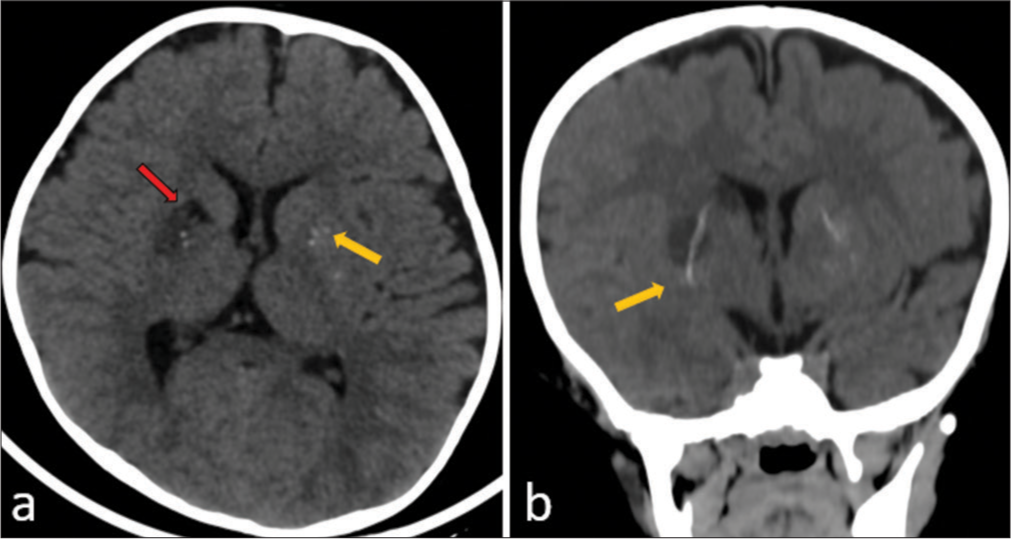Translate this page into:
Mineralizing angiopathy with basal ganglia stroke
*Corresponding author: Shirish Balasaheb Deshmukh, Department of Radiology, KEM Hospital, Mumbai, Maharashtra, India. deshmukhshirish21@gmail.com
-
Received: ,
Accepted: ,
How to cite this article: Deshmukh SB, Gala F. Mineralizing angiopathy with basal ganglia stroke. Wadia J Women Child Health. 2024;3:104-5. doi: 10.25259/WJWCH_37_2024
A 1.5-year-old male child presented with difficulty in walking and weakness of the left upper and lower limbs which developed after a minor fall while playing 2 days back, as noticed by the mother. He was referred to our department for magnetic resonance imaging of the brain which revealed acute infarct in the right lentiform nucleus. Magnetic resonance time-of-flight angiography showed no significant abnormality with normal course and caliber of the right middle cerebral artery [Figure 1].

- (a) Axial diffusion and (b) apparent diffusion coefficient images show acute infarct in the right lentiform nucleus. (c) Time-of-flight magnetic resonance angiogram shows normal signal in intracranial vasculature with no major vessel occlusion.
Unenhanced computed tomography (CT) scan of the brain revealed linear calcifications in both the basal ganglia along the lenticulostriate arteries suggesting the diagnosis of mineralizing angiopathy [Figure 2].

- (a) Unenhanced axial and (b) coronal reformatted maximum intensity projection computed tomography images of the brain show linear calcification along the lenticulostriate arteries on both sides (yellow arrows in a and b) and hypodense infarct in the right lentiform nucleus (red arrow in a).
Mineralizing angiopathy is a cause of basal ganglia stroke in infants. It has good long-term outcome with standard antithrombotic therapy. Therefore, correct diagnosis by imaging is required to avoid a battery of other investigations for infantile stroke like prothrombotic workup.[1]
Thin-sliced CT with multiplanar reconstruction is the investigation of choice to pick up the linear calcification of these vessels.
Ethical approval
Institutional Review Board approval is not required.
Declaration of patient consent
The authors certify that they have obtained all appropriate patient consent.
Conflicts of interest
There are no conflicts of interest.
Use of artificial intelligence (AI)-assisted technology for manuscript preparation
The authors confirm that there was no use of artificial intelligence (AI)-assisted technology for assisting in the writing or editing of the manuscript and no images were manipulated using AI.
Financial support and sponsorship
Nil.
References
- Mineralizing angiopathy of lenticulostriate arteries with infantile basal ganglia infarct following minor head trauma: A case series. Ann Indian Acad Neurol. 2019;22:316-9.
- [CrossRef] [PubMed] [Google Scholar]





